Plant growth and development, such as production of leaves, stems, roots, and floral organs is a result of primary metabolic processes. Byproducts of photosynthesis are shuttled throughout the plant and utilized in developing tissues. However, there are several other processes in plants such as coloration, warding off predators and infection, promoting pollination and symbiotic relationships, and defense against environmental conditions such as light and temperature. This is what we refer to as secondary metabolism. When these processes come into play, resources are diverted away from the primary metabolism (growth) and used to generate various attributes crucial to crop quality from a human consumption standpoint.
When we consume plants as food or medicine, many of these compounds can have powerful effects on basic body functions, alleviation of chronic disease symptoms, prevention of cancers, and provide relief to general psychological issues like anxiety and stress. Within controlled environments, we can influence these natural defense mechanisms in plants by manipulating light intensity and light quality. It’s important to consider that there is a tradeoff between encouraging plant growth (primary metabolism) and boosting production of secondary metabolites that may increase the quality of your crop. In this article, we focus on the secondary metabolites (flavonoids, terpenes, cannabinoids, and others) plants produce in response to environmental cues, how they affect crop quality, and what you can do to take advantage of these mechanisms.
Flavonoids
In plants, flavonoids primarily serve as insect attractants (coloring pollen), signals for forming relationships with soil microbes, antioxidants (which scavenge and eliminate compounds that may cause photobleaching and growth inhibition), and photo-protectants (which dissipate harmful wavelengths to protect cells). Anthocyanins are a class of flavonoids visible as a red to purple coloration of leaf tissue. Red-leaf lettuce and herbs often contain high amounts of these flavonoids, essentially functioning as sunblock for plants. When a leaf surface is exposed to blue (400-500nm) or ultraviolet (300-400nm) wavelengths of a high enough intensity (differs between species), the plant’s secondary metabolism is triggered for a few reasons. Blue and ultraviolet (UV) light have very high frequencies which means they carry a tremendous amount of energy that can be damaging to various cellular functions within the plant. In order to both protect these tissues from incoming energy as well as clean up any “free radicals” produced in the cell, plants will produce anthocyanins.
Accumulation of anthocyanins in response to blue or UV light scales up with increasing light intensity. Eventually, an equilibrium of photoprotection by anthocyanins and light capture by terpenoids (chlorophyll and carotenoids) is established. Its important to reinforce that this is a secondary process of the plant, which diverts energy away from growth. If the intensity is high enough, a visible change in crop coloration can be observed. Green light (500-550 nm) can reverse many functions in plants that are otherwise stimulated by exposure to blue light. Too much green light relative to blue can completely reverse this response. A red-leaf lettuce grown under a high proportion of green may not turn red at all. Those growing under HPS lamps (which have a very small proportion of blue light relative to green, especially compared to broad-spectrum LED fixtures) may struggle to stimulate anthocyanin production in salad crops. Incorporating a fixture providing additional blue-light isn’t likely to stimulate crop coloration unless there is significantly more blue than the portion of green supplied by the HPS. In this case, it may be useful to alter crop lighting just before harvest after the desired amount of growth has occurred. This is referred to as an “end-of-production” light treatment or EOP.
Recent EOP work by Dr. Garrett Owen and Dr. Roberto Lopez demonstrated an increase in coloration (from green to red/dark red) of four lettuce varieties when provided with 100 µmol/m2/s by supplemental LED lighting (red, blue, and a 1:1 ratio) for 5 to 7 days prior to harvest. Their research also demonstrated that incremental increases in supplemental light intensity from 0 to 100 µmol/m2/s resulted in increasing amounts of pigmentation. These varieties were also grown under HPS fixtures (providing an additional 70 µmol/m2/s), however, this EOP treatment was of insufficient light quality to reach the desired level of crop coloration for market. The take away message for implementing EOP treatments to increase crop quality is that crop coloration is more responsive to blue light so long as it is provided at a sufficient intensity. Furthermore, to prevent growth inhibition, this type of supplemental lighting is more efficient when used as an EOP treatment.
Terpenes
Unlike flavonoids, which are mostly perceived as bitter, terpenes have distinct scents and flavors. These are very fluid oils that impart wonderful attributes to flowers, herbs, and medicinal plants and greatly increase product quality if produced in sufficient quantities. For example, limonene is the major terpene present in the essential oil of lemons and myrcene for mangoes. These same terpenes can be produced within other species such as various herbs and even Cannabis. The largest concentration is typically found within non-glandular trichomes (such as leaf hairs on tomato or Cannabis leaves) and glandular trichomes (such as the bulbous heads seen on sugar leaves and calyces of Cannabis). Limited research has been performed on the impact of various wavelengths on terpene biosynthesis, but several plant physiologists believe that specific wavelengths are required for activation of the necessary metabolic components. Additionally, increasing light intensity signals certain plants to produce more glandular trichomes. There is some evidence that these additional trichomes are generated as a site for defensive flavonoid secretion (as mentioned before, these compounds protect against excess light intensity and UV light). The increased synthesis of glandular trichomes creates new sites for terpene biosynthesis and storage, which may influence overall terpene concentrations in several plant species. Overall, terpene synthesis is a hot topic for researchers who are studying the effects of light intensity and light quality.
Cannabinoids
Cannabinoids are a unique class of compounds found only in Cannabis. These sticky resinous oils are produced within trichomes during the flowering period and are thought to both protect the developing flowers from insects (sticky trap) as well as excess heat under shifting solar conditions. There are over a hundred different cannabinoids including Δ9-tetrahyrdocannabinol (THC), cannabidiol (CBD), cannabigerol (CBG), cannabinol (CBN) and many others. CBG-A (the carboxylated acidic form of CBG) is the precursor substrate for production of THC and CBD. It does not produce the typical marijuana “high,” but certain researchers are evaluating specific medicinal effects, such as alleviating symptoms from neuropathy, degenerative brain disorders, glaucoma, certain cancers, and anxiety. Most varieties of Cannabis have been bred to produce high amounts of THC and/or CBD, leaving behind low concentrations of most other cannabinoids that carry many medicinal qualities. Due to the current legal status of Cannabis with most federal governments, there is very little scholarly research that investigates the effects of various wavelengths and intensity on production of cannabinoids. The work that has been done was with cultivars of inferior quality compared to anything on the market today. However, there is more and more peer-reviewed research being conducted on Cannabis, and as laws change quality research will be published in this area.
We do know that UV light and possibly even short wavelength (~400-420nm) blue light can stimulate production of cannabinoids, although production of these secondary metabolites will occur regardless and this effect is only a “boost” in production as opposed to being a requirement. We cannot say much about which wavelengths of light result in increased content of specific cannabinoids, however we are continually investigating the effects of different wavelengths on secondary metabolites.
Photo-acclimation
So long as carbon dioxide, water, and nutrients are not limiting growth of the plant and it is a fast-growing species, higher light intensities will result in faster growth and increased production of secondary metabolites. However, too high of a light intensity can be damaging to cells, especially in sensitive species, producing free radicals such as hydrogen peroxide within cells. On the surface, you might notice this effect as photobleaching (tan to white patches on leaves) if the plant is not photoacclimated to that intensity. Many growers notice this issue when they are transferring plants from a seedling propagation or rooting phase in which light intensity is low, into a highly productive phase under high light intensity. As a part of the photoacclimation process, highly productive or fast-growing species will likely accumulate more chlorophyll to harvest more light. If intensity is too high, production of various carotenoids (for more info, refer to […pigments & photoreceptors]) is increased to protect the photosynthetic reaction centers and dissipate some light.
This is why increasing light intensity can have diminishing returns since more light is dissipated in response to higher light intensity. To photoacclimate your plants productively with little to no photobleaching (which inhibits growth), it is best to incrementally increase light intensity or use a shade cloth for a week or two. Slowly acclimating plants to higher light intensities can be achieved using dimmable lights after determining what your desired PPFD will be (depending on your fixture capability and species) and creating a series of incremental increases in intensity (beginning slightly above the propagation intensity) over time. A less sophisticated way to achieve this same outcome (if your lights are not capable of dimming) would require you to start with the plant-lamp separation distance much larger than desired and then slowly move the lamp closer to the plants (or vice versa) over the same duration.
As previously mentioned, anthocyanins can accumulate in leaves of many species in response to blue or UV light of sufficient intensity. A similar mechanism protects the fruit of some crops such as tomatoes and peppers. When growing green peppers, you may notice that some fruit surfaces exposed to more light have patches of yellow to orange coloration. This accumulation of photoprotective carotenoids prevents damage to the fruit. Lycopene, an orange to red carotenoid, plays a similar role in tomato fruits. Just like most other light-induced secondary metabolites, production of these carotenoids occurs at a faster rate as light intensity increases.
Conclusion
We know that the proportion of wavelengths supplied to plants as well as intensity completely changes the photomorphogenic outcomes as well as phytochemical concentrations (secondary metabolites). Increasing light intensity induces production of various secondary metabolites in plants as a form of protection. Blue and UV light have the most powerful influence on secondary metabolism relative to other wavelengths and this scales with intensity. From a production standpoint, these metabolites often improve product quality both due to their medicinal benefits in humans as well as crop coloring effects. This differs depending on the genetics at play with much variability among species. Some species are more tolerant to this response and require higher light intensities to show any response while others do not. One proven method to “get the best of both worlds” is to utilize an EOP treatment in which plants grow and develop under optimal conditions for primary metabolism (broad spectrum), and are then transferred beneath a secondary metabolism promoting light treatment (higher intensity or specific wavelengths) prior to harvest after major crop growth has occurred. Overall, the most important aspect to remember is that secondary metabolism diverts resources away from plant growth. When selecting or making any changes to your lighting system, consider these innate plant responses to ensure your system is optimal for your intended species and market.




